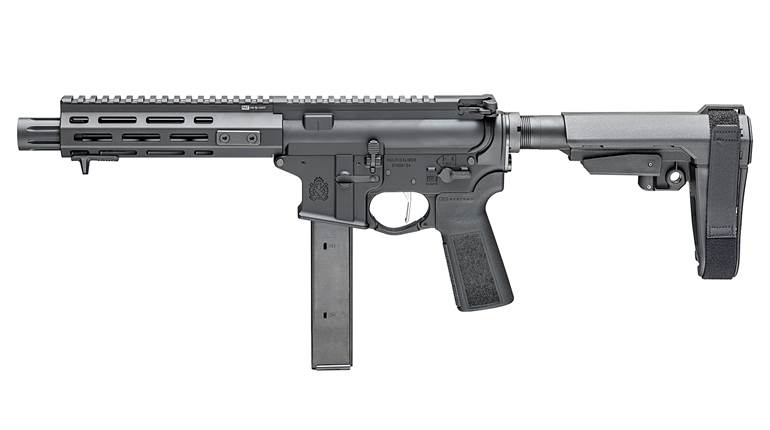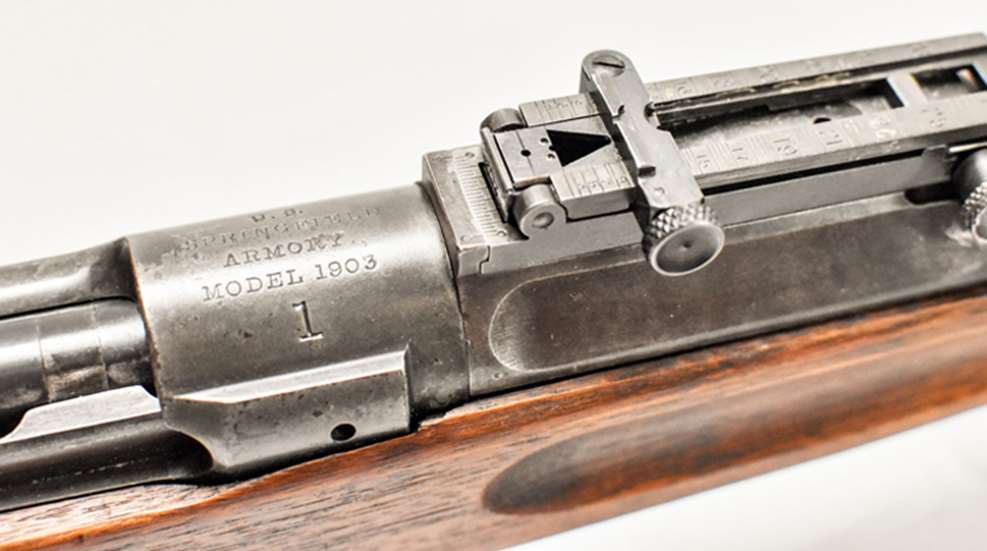
The United States Rifle, Caliber .30, Model of 1903, is one of the most iconic American small arms of the 20th century. Adopted on June 19, 1903, the Springfield M1903 replaced the M1892 Krag–Jørgensen, and would be one of two rifles with which the United States fought World War I. It went on to see service throughout World War II and, despite the Chief of Ordnance declaring the venerable M1903 obsolete on July 24, 1947, served on through the Korean War and into the early stages of the Vietnam War. In this article we will trace the fascinating history of just one M1903, the very first, serial No. 1. No. 1 has a very unique history all in its own finding its way to the Western Front in 1918 and later surviving the ravages of a fire which swept through Springfield Armory.

Rifle, Caliber .30, Model of 1903, serial No. 1 (Andrew Schmidt Photography, LLC)
We have been lucky enough to be allowed access to the rifle, which is currently cared for and maintained by the National Parks Service at Springfield Armory National Historic Site in Springfield, Mass. Through close up photographs and detailed archival research we will explore this history of No. 1 and attempt to share its fascinating story.
Historically, firearms from the very beginning of serialized production are often considered significant and are set aside out of inventory to both provide a pattern of how a gun was initially produced or as a historically significant artifact to be preserved for the future. Indeed the Springfield Armory retains a number of serial No. 1 firearms, including the first M1892 Krag-Jørgensen. This was the case with the first M1903 rifle made by the Rock Island Arsenal and remains part of the Rock Island Arsenal Museum’s collection today. The story of the first M1903 produced by Springfield Armory is a little different and it is a mystery as to how it entered the U.S. Army’s inventory for issue.
Some Technical Information on Springfield Armory’s Serial No. 1 M1903:
Bolt: Heat Lot
Barrel: 4-09 SA
Stock: J inspected (stamped in the cutout well), Not Proof fired (no “P” stamp behind trigger guard). Two stock screws. Stock is likely a replacement as it has no final inspector stamp on the left side.
Rear Sights: Curved leg “7’s” (Springfield), Volley Notch, Small dished windage knob and dished elevation knob.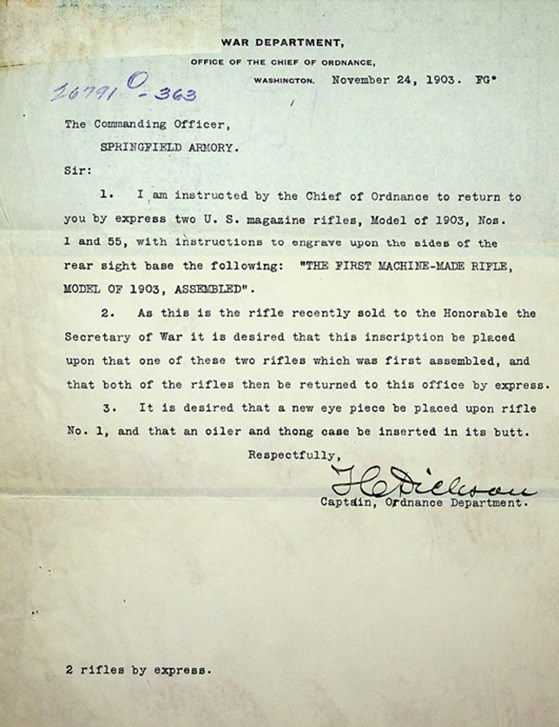
T.C. Dickson wrote to the commanding officer of Springfield Armory, Lt. Colonel Frank K. Phipps, to advise that he had been directed by the Chief of Ordnance, then Brigadier General William Crozier, to return two Model 1903 rifles to the armory. (Archival Research Group)
The documentation discovered by Archival Research Group at both Wash., D.C., and College Park, Md., National Archive locations has revealed much of the individual story of the first M1903 produced. No. 1 was the first rifle to be assembled when serialized production began at the historic armory in Springfield, Mass., in November 1903. Preparations for production of the M1903 had begun earlier in June 1903. On Nov. 24, 1903 Capt. T.C. Dickson wrote to the commanding officer of Springfield Armory, Lt. Colonel Frank K. Phipps, to advise that he had been directed by the Chief of Ordnance, then Brigadier General William Crozier, to return two Model 1903 rifles to the armory. The documents relating to their initial transfer from Springfield Armory have not been found so it is unclear for what exact purpose they were first sent to Brig. Gen. Crozier’s offices. We do know, however, that the two rifles were serial numbers 1 and 55. Phipps was informed that upon receipt of the rifles a number of changes would be made including:
From Dickson’s letter we know that the rear sight base of serial number 55 was to be engraved with the following: “THE FIRST MACHINE-MADE RIFLE, MODEL OF 1903 ASSEMBLED.” With no documentary evidence to explain the selection of number 55, along with #1, it is not immediately clear why this engraving, which may seem more fitting for serial No. 1, was ordered. Perhaps a clue is in the words ‘machine-made,’ Springfield had early teething problems getting the M1903 into mass production, it is possible that number 55 was the first rifle to be made using entirely machine processes. It is also important to note that Dickson informs Phipps that one of the rifles, probably serial No. 55 had recently been sold to the Secretary of War William Howard Taft. Documentation is invaluable, but it sometimes creates more questions than answers. In this case the wording of the letter does not make it explicitly clear which rifle Taft purchased, although the wording of the subsequent reply on Dec. 9 suggests it may have been 55. Taft would later go on to become the 27th President of the United States and the 10th Chief Justice of the Supreme Court. The William Howard Taft National Historic Site in Cincinnati, Ohio was contacted with regard to both No. 1 and No. 55. Sadly, they had no knowledge of either and their connection to the former President.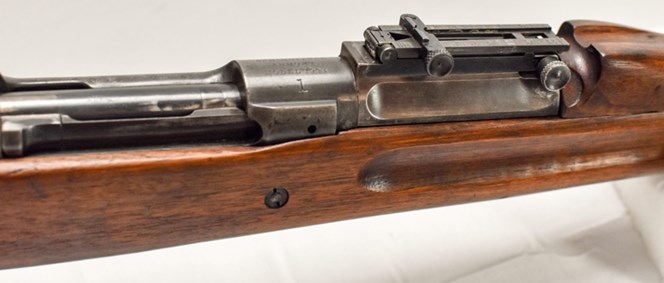
Close up of the rifle’s receiver, prominent serial number marking and rear sight (Andrew Schmidt Photography, LLC).
The most intriguing part of Dickson’s letter is a request that a “new eye piece be placed upon rifle No. 1, and that an oiler and thong case be inserted in its butt.” When inspecting this rifle at Springfield Armory National Historic site, no evidence was found that exhibited either a scope mount or nonstandard sight being affixed to the rifle, such as drilled/filled holes. With no period photographs of the rifle in that condition, Dickson’s meaning of ‘new eyepiece’ remains unclear but likely refers to the sliding, notched rear sight which slid the sight’s ladder. It should be noted that at the time of the documentation, No. 1 was in the Rod Bayonet configuration.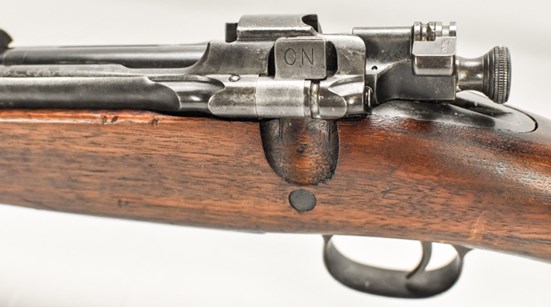
Note that the rifle’s replacement stock, added after the original was destroyed by the 1931 museum fire, it has been inspected (denoted by J in the cutout), but has no final inspector stamp (Andrew Schmidt Photography, LLC).
Colonel Phipps replied to Dickson on Dec. 9, 1903, noting that the “No. 1 rifle, Model of 1903 is this day returned, by express, with a new eyepiece, oiler and thong case in the butt as directed.” Rifle number 55 was not yet ready to ship and Phipps acknowledged a letter dated the December 3, that requested the fitting of a civilian sight made by the Lyman Company. Regrettably, the location of Serial Number 55 is not presently known to either of the authors for a possible comparison to the condition described in the document.
From late 1903 the documentation trail goes cold until the rifle later resurfaces in France, discovered by an Ordnance Officer with the American Expeditionary Force (AEF), at the end of the Great War. What we do know, however, is that No. 1 underwent the same alterations as many of the other M1903 rifles underwent before the war. The standard set of improvements were made, including the removal of the rifle’s rod bayonet, a new front sight and a new bayonet boss and nose cap was fitted. We know from examining the rifle that No. 1 was converted from the original .30-03 chambering to the improved .30-06 round in 1909 (noted by the barrel date).
A panorama of Camp Pontanezen, near Brest, No. 1 arrived in France and was later discovered at the camp at the end of the war (Library of Congress).
We pick up the trail again on Oct. 31, 1919, when Col. N. F. Ramsey at “Camp Pontanesen” wrote to the Chief of Ordnance for the AEF to inform him of the discovery of M1903 No. 1. It should be noted that this is a typographical error, and that Col. Ramsey is likely referring to Camp Pontanezen in Brest, France. He later spells the camp’s name correctly in the body of his letter. Camp Pontanezen was a huge depot which served as a debarkation and embarkation point where American troops arrived and departed from France. A huge number of American soldiers passed through Camp Potanezen, built just a few miles from the port of Brest, through which nearly 800,000 troops arrived in France. Established in April 1918, Camp Pontanezen at its height covered over 1,000 acres and could house as many as 80,000 men. The camp was an important transit hub for troops before they began the journey east toward the frontlines. At the war’s conclusion it served in reserve, acting as a funneling point for the men of the AEF to begin their voyage back to the United States.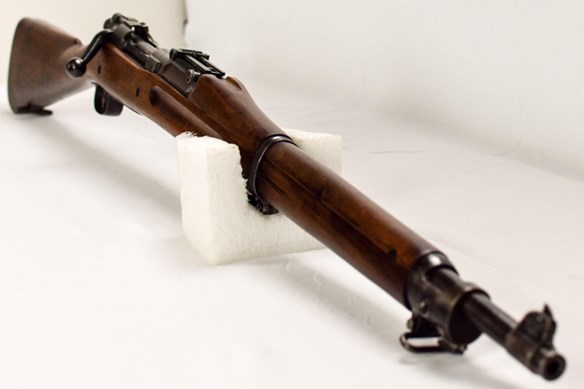
Rifle, Caliber .30, Model of 1903, serial No. 1 (Andrew Schmidt Photography, LLC).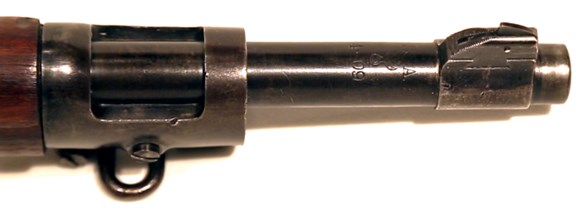
The rifle, like most M1903's was re-barreled, here we can see No. 1 was re-barreled in April 1909 (Courtesy of the Friends of the Springfield Armory NHS).
In his letter to the AEF’s Chief of Ordnance, Ramsey notes:
“There was recently turned in to the Ordnance Officer, Camp Pontanezen, Brest, by the 1st Division a US rifle 30 with serial No. 1 on the receiver. This receiver is fitted with a barrel manufactured in 1909. Owing to the fact of this rifle having been used by the 1st Division and its low serial number, it has been forwarded to you by the Ordnance Sergeant, F.W. Bressler for such disposition as you may consider desirable.”
It should be noted that the rifle’s current barrel date does, in fact, match up to this particular document. But once again after 1919, we have another period with little documentary evidence. It is not until July 8, 1925 when Colonel H.W. Schull (who was the Commanding Officer at Springfield Armory) sent a request to the Office of Chief of Ordnance in Washington D.C. that the rifle’s paper trail resurfaces. Col. Schull requested that “that U.S. Rifle No. 1, Model 1903, which is understood be in the possession of the Ordnance Office, be sent to this armory for examination and comparison with the current product,” Schull also requested that the historically significant serial No. 1 subsequently be retained for exhibition at the armory’s museum.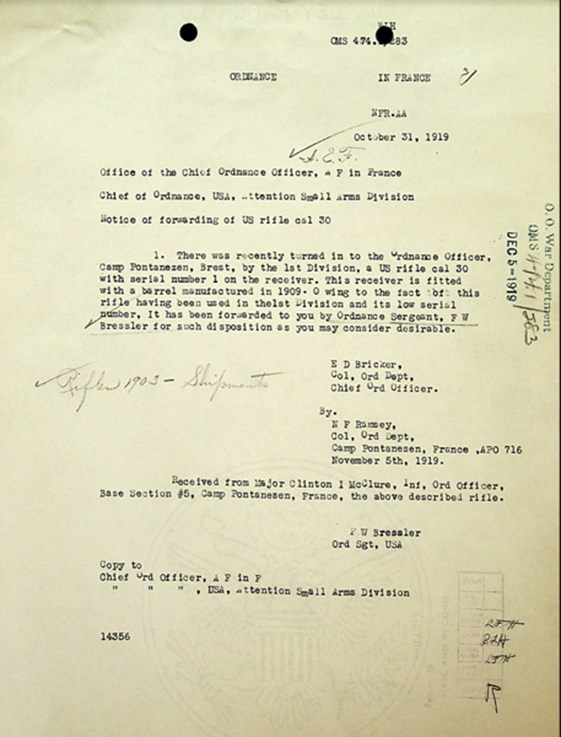
October 1919 Memo advising the Chief of Ordnance in the United States that US rifle bearing serial No. 1 had been discovered at Camp Pontanezen in Brest, France (Archival Research Group).
Several weeks later, by the direction of Capt. N. H. Strickland, who was the Assistant Ordnance Officer at Wash., D.C., replied on August 4, 1925 that the rifle would be shipped to the armory in accordance with their request. It is at this point that the official paper trail for the rifle finally peters out after this last memorandum. 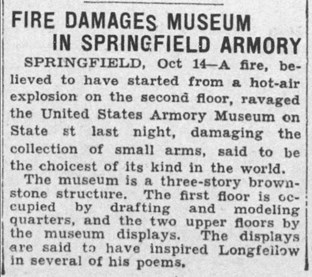
From visual inspection of the rifle itself, however, we know that six years later, on Oct. 13, 1931, M1903 serial No. 1 was one of the many items on display at the museum to fall victim to a devastating fire. The vast majority of the museum’s collection was damaged in the fire, on Oct. 14, The Boston Globe reported that the fire had been caused by a “hot-gas explosion” on the second floor of the museum but did not elaborate further. The first floor was reserved for drafting and modeling quarters, while the second and third floors were reserved for the museum’s displays. As a result of damage caused by the fire No. 1 was restored and restocked. It should be noted that the rifle in its present condition is more of a reflection of what condition it was restored to, rather than the configuration it was in during its service to the United States military. It was in its restored condition that it was returned to display and that it had a final encounter with one of its earlier owners.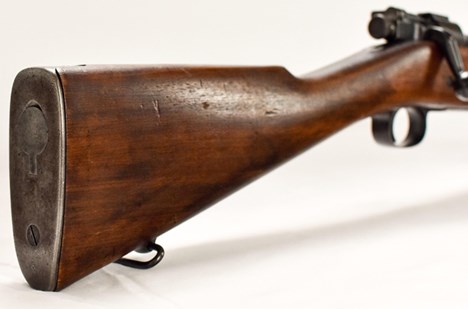
Detail view of No. 1’s butt (Andrew Schmidt Photography, LLC).
The story does not end with the rifle’s restoration, however, as a recollection from a soldier who claimed to have been issued No. 1 has allowed us to continue our research. In 1974, Wayne Phaneuf, a journalist with the Springfield Daily News, interviewed a World War I veteran at Springfield Armory Museum who claimed M1903 serial No. 1 was issued to him during the war. The elderly veteran was Frank C. Lynaugh, who was 80 at that time, had been visiting friends in the area and decided to browse the museum. He introduced himself to the museum’s curator, Thomas Wallace, and informed him that he had been issued M1903 serial No. 1 in 1917. Fifty-six years after the war had ended and he’d last seen his rifle, Mr. Wallace permitted Mr. Lynaugh to hold the rifle and a photograph of the reunion was taken.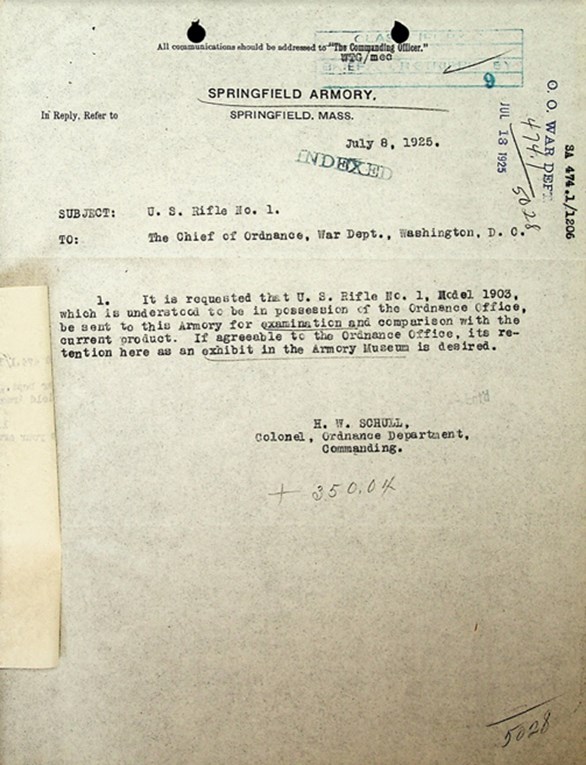
Letter from Colonel Schull, Superintendent of Springfield Armory requesting the Office of Chief of Ordnance in Wash., D.C., forward U.S. Rifle No. 1, Model 1903 be forwarded to their museum (Archival Research Group).
Mr. Lynaugh stated that he was issued the rifle in Syracuse, N.Y., and that it was still covered in Cosmoline when he received it. Mr. Lynaugh is reported to have said he left Syracuse with E Company, 49th Infantry for Camp Merritt in New Jersey in July 1917. From our research we know that he and his company arrived at Camp Merritt in November 1917 before moving from Camp Merritt to Camp Upton in July 1918. While the dates of movements don’t match exactly, Mr. Lynaugh can be forgiven slight discrepancies. From there Mr. Lynaugh told the Springfield Daily News he sailed to Europe on the “Queen of Italy” and arrived in France with his M1903 rifle. He further states that while training with a signal corps unit, the rifle was taken away from him and replaced with an M1917, and he was not pleased with the transition. “I hated the darn Enfields,” he said, and wished he could have his Springfield rifle back. The article closes out with Mr. Lynaugh propositioning Mr. Wallace, “if you ever want to sell it, will you let me know … .” As most can conclude, it was not for sale and likely never will be.
In the cablegram mentioned above written by Col. Ramsey in 1919, it states that M1903 serial No. 1 was in use by the 1st Division. Mr. Lynaugh was with the 49th Infantry, which was attached to the 83rd Depot Division. The 83rd Division did not see combat as a complete unit but rather supplied replacements for front line units. Consulting with the First Division Museum, located in Wheaton, Ill., they have advised that they have no record of a Frank C. Lynaugh in their muster rolls for personnel serving in the AEF during World War I. They tried multiple spelling possibilities of “Lynaugh” in case his name was incorrectly spelled in their records. It is possible that after Lynaugh handed in serial No. 1 that the rifle found its way to a unit with the 1st Division. We can also assume that M1903 serial No. 1, both arrived and left France through Camp Pontanezen and the port of Brest.
While the U.S. Army’s official paper trail for the rifle ends in 1925, Mr. Lynaugh’s service history gives us the opportunity to fill in some of the gaps in the rifle’s history during World War I. In an effort to trace the No. 1’s movements, we explored Mr. Lynaugh’s service history. 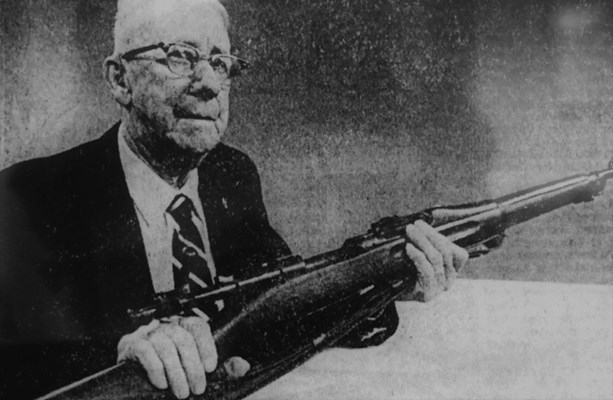
80-year-old Frank Lynaugh poses with No. 1, taken in 1974 by Marie Sarno for the local newspaper (Springfield Daily News)
Frank Clifford Lynaugh enlisted on July 25, 1917, at the age of 23. He subsequently underwent basic training with the 49th Infantry Regiment. From an examination of Muster Rolls we know that by June 1918, he had been promoted to sergeant when he transferred from the 49th Infantry’s E Company to the regiment’s Headquarters Company. In July 1918, according to the 49th Infantry’s morning reports Lynaugh’s company left Camp Upton on Long Island and traveled to France aboard the Regina d’Italia or “Queen of Italy,” a twin screw steamer pressed into service in May 1918. This corresponds with the ship Lynaugh mentioned in his interview with the Springfield Daily News.
Lynaugh arrived in France on July 30, and marched to Camp Pontanezen the next day. In August 1918 he was transferred to the 83rd Division, 2nd Depot’s Signal School. This transfer from the 49th Infantry also corroborates Lynaugh’s suggestion that his M1903 marked with the serial No. 1 was exchanged for another rifle when he transferred. It is difficult to trace either Lynaugh or his rifle’s movements any further, we do not know if made it to the front after his training at the Signal School or if No. 1 ever fired a shot in anger. We do know, however, that Sergeant Lynaugh returned to the United States aboard the USS Frederick, departing the from Brest on Feb. 19, 1919, probably following another stay at Camp Pontanezen. He was finally discharged from the army on March 19, 1919, at Camp Devens, Mass. Mr. Lynaugh died in 1981 at the age of 87.
While Mr. Lynaugh’s accounts do not entirely match up with the paperwork attributed to the rifle, a number of elements of his recollections have been confirmed by our research. This suggests that Lynaugh’s recollections are accurate and that M1903 serial No. 1 did travel across to France as his service rifle.
The story of the first M1903 assembled by Springfield Armory is a fascinating one, against all odds the rifle was initially purchased by President Taft and found its way into active service and across the Atlantic to war. Its travels only serve to amplify its significance and importance as an artifact which gives us a window into the history of the M1903 and the U.S. Army. There is a bit of a mantra well known to collectors: “if this rifle could talk, the story it could tell.” It is obvious that No. 1 has a truly fascinating story which up until now may have been lost to time.
The authors would like to extend their appreciation to Springfield Armory National Historic Site Museum Curator Alex MacKenzie for facilitating access to this priceless artifact and his hospitality. The authors would also like to extend their appreciation to Lori Miller from Red Bird Research, LLC. Her archival expertise in personnel records at National Archives in St. Louis, Mo., allowed us to track Sgt. Lynaugh’s service history and confirm his accounts detailed in his interview which proved invaluable. Our thanks also to the Friends of the Springfield Armory NHS for the use of some of their photographs.
Andrew Stolinski is a military historian who focuses on first half 20th century American small arms. He has published multiple articles and has assisted several museums with adding provenance to their military artifacts using primary data from the National Archives. He has founded Archival Research Group, LLC (ArchivalResearchGroup.com) which specializes on digitizing small arms related files for their online library making firearm related files accessible from the National Archives.
Matthew Moss is a military historian who specializes in the history, development and use of firearms. He has written for numerous publications and recently published his first book, he founded historicalfirearms.info and co-founded armourersbench.com a multimedia project examining the history of some of the world’s most interesting and important firearms.
Additional Reading:
Shedding New Light on the "Air Service" Springfield M1903













